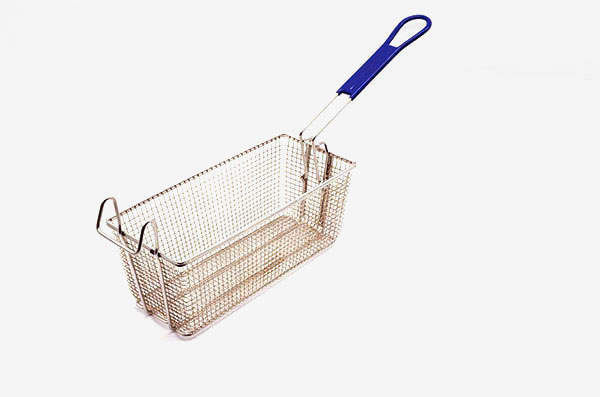What are the surface treatment technologies of blast basket
1 PVD process
PVD (physical vapor deposition) - physical vapor deposition: refers to the physical process of material transfer, transfer of atoms or molecules from the source to the surface of the substrate. Its function is to spray some particles with special properties (high strength, wear resistance, heat dissipation, corrosion resistance, etc.) on the matrix with low performance, so that the matrix has better performance. PVD basic methods: vacuum evaporation, sputtering, ion plating (hollow cathode ion plating, hot cathode ion plating, arc ion plating, active reaction ion plating, RF ion plating, DC discharge ion plating).
The successful mass production of iPhone x stainless steel plus PVD technology indicates that the PVD technology scheme of stainless steel plus plastic middle frame has been mature, adding an additional option for the surface treatment scheme of mobile phone manufacturers.
The middle frame of Xiaomi 6 stainless steel also adopts PVD coating process
2 sandblasting (shot blasting) treatment
Sand blasting is to use compressed air as the power to form a high-speed jet beam to spray materials (copper ore, quartz sand, carborundum, iron sand, sea sand) to the surface of the workpiece to be treated at high speed, so as to change the appearance or shape of the workpiece surface.
Sandblasting has a strong application in engineering and surface technology, such as: improving the viscosity of adhesive parts, decontamination, optimizing the surface burr after machining, surface matte treatment.
Sand blasting process is more uniform than manual grinding. This method of stainless steel treatment creates low-key and durable features of products.
3 chemical treatment
Chemical treatment is a general term of chemical or electrochemical treatment to produce a layer of stable compound on the surface of stainless steel. Electroplating, as we often say, is treated by electrochemistry.
It belongs to this method that rust is removed by acid solution, anodic dissolution (electrolysis), phosphate treatment, chromate treatment, blackening, anodizing, etc. alone or in combination to form a protective film on the metal surface. This method can achieve a complex pattern effect and create a retro or modern design demand.

4 mirror treatment
The mirror surface treatment of stainless steel is simply to polish the surface of stainless steel. The polishing methods include physical polishing and chemical polishing. Local polishing can also be carried out on stainless steel surface. The polishing grade is divided into ordinary polishing, ordinary 6K, fine grinding 8K and fine grinding 10K. Mirror gives people a sense of simplicity and fashion in the future.
5 surface coloring
Stainless steel coloring not only endows stainless steel products with various colors, increases the variety of designs, but also improves the wear resistance and corrosion resistance of products. There are many methods of surface colouring, which can be divided into: 1. Chemical oxidation colouring; 2. Electrochemical oxidation colouring; 3. Ion deposition oxide colouring; 4. High temperature oxidation colouring; 5. Gas phase cracking colouring.
6 surface wire drawing treatment
Drawing process drawing is a common method for stainless steel products. It can be made into straight lines, random lines, threads, corrugations and spiral lines according to the needs of decoration. Stainless steel surface wire drawing gives people super good handle, fine luster, wear-resistant surface and individual texture effect. It is widely used in electronic equipment, kitchen appliances and mechanical equipment.
7 spraying
Stainless steel spraying is substantially different from the coloring mentioned above. According to different materials, some spraying may damage the oxide layer on stainless steel surface. But spray can be used to achieve different colors of stainless steel products with simple process, and can also use different spray paint to change the feel of stainless steel. Like the stainless steel water cup we use in our daily life, we will use the spraying process.
Article origin: Jiangmen fried baskethttp://www.jmhylwj.com
-
06-05
Processing technology of barbecue net
After the barbecue net is processed and manufactured, it is generally required to stop the surface treatment, so that the product has the characteristics of beauty, rust prevention and corrosion prevention. Generally speaking, there are two ways to treat the surface of barbecue net, galvanizing and polishing. Here we will introduce these two processes: galvanizing, that is, cold plating, which is
-
06-05
High temperature resistance of stainless steel mesh structure
The stainless steel mesh structure of Jiangmen blast basket is generally used in acid, alkali and high temperature environment. In order to make the stainless steel mesh work normally in high temperature, we need to know the acceptable temperature of the stainless steel mesh. Stainless steel mesh is made of stainless steel wire, and its raw materials are divided into SUS302, SUS304, SUS316, SUS304
-
06-05
Style and classification of barbecue net
Style and classification of barbecue netClassification of barbecue net: it can be divided into round flat barbecue net, round concave barbecue net, square flat barbecue net and square concave barbecue net according to its shapeDivided into: galvanized barbecue wire, galvanized barbecue wire, stainless steel barbecue wireIt is divided into barbecue net with handle (also known as barbecue rack) and
-
06-05
What are the differences between 304 stainless steel and 316 stainless steel?
304 stainless steel and 316 stainless steel belong to austenitic stainless steel. Austenitic stainless steel is generally used in corrosion-resistant environment, with excellent mechanical properties. Many nickel and chromium also have excellent corrosion resistance. In addition, many austenitic stainless steels are weldable and formable. Two commonly used austenitic stainless steel grades are 304

